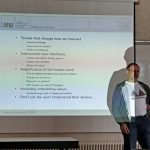 Albrecht Schmidt Albrecht Schmidt |
 not available not available |
 Sun, 11.03.2018 Sun, 11.03.2018 |
|---|
In this keynote, we discussed the design properties of good intervention techniques to support interaction with new technologies. A key question we discussed is “Do we want to do an evolution or a revolution for designing products?”. Throughout a set of interactive activities, we discussed the rationale behind revolutionizing products and how to define their key features. We also discussed the interplay between artificial intelligence and humans to achieve optimal user experiences.
We discussed several topics such as:
- The tradeoff between standardization vs. novelty in the interaction technique
- s: Needing tutorials on how to interact with every new object around us does not scale. However, it could be relevant in ground-breaking products.
- Examples for systems optimizing the usability for wrong stakeholders (E.g.: Door knob reducing the workload on maintenance person instead of the customers)
- We need technologies that disappears in our daily interaction and enhance it
- The complexity of current interaction techniques in IoT products might stem from them not being “common mass commodity” yet, not from the inherent complexity of the technique (if products become successful ⇒ they will be easy to use vs. if they are easy to use ⇒ they will become successful).
- Social networks are a game changer in the design process. People are now able to give early opinions about a product before it exists.
- Can AI solutions replace us because they are “more intelligent”? Maybe we don’t need intelligence just for productivity but because humans as species are built to favour them from an evolutionary point of view.
- Do AI solutions strip us away from our autonomy? It depends on the framing of control in the solution. An approach is we do not need too much control on irrelevant tasks (granularity is the key).
List of mini-activities
- Brainstorm for 90 seconds: How many objects do you have in your house that are linked to electricity?
- Brainstorm for 2 minutes: What can humans do that computers can’t do?
- Brainstorm for 5 minutes: What intervention options would you add to the following products (car, robot, fridge)?




